1973 CHEVROLET CAMARO Towing
[x] Cancel search: TowingPage 13 of 84
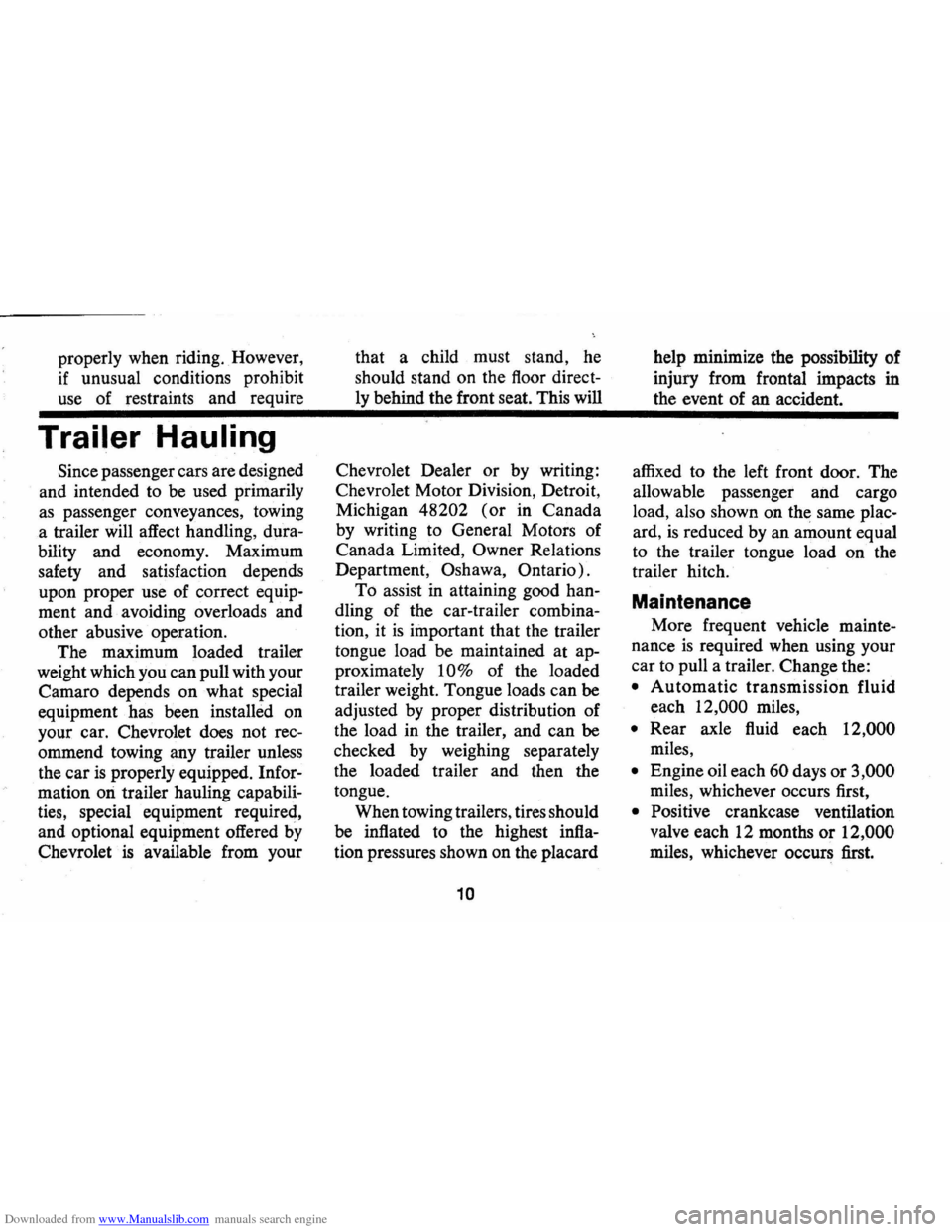
Downloaded from www.Manualslib.com manuals search engine properly when riding. However,
if unusual conditions prohibit
use of restraints and require
Trailer Hauling
Since passenger cars are designed
and intended to be used primarily
as passenger conveyances, towing
a trailer will affect handling, dura
bility and economy. Maximum
safety and satisfaction depends
upon proper use of correct equip
ment and· avoiding overloads and
other abusive operation.
The maximum loaded trailer
weight which you can pull with your
Camaro depends on what special
equipment has been installed on
your car. Chevrolet does not rec
ommend towing any trailer unless
the car
is properly equipped. Infor
mation
ori trailer hauling capabili
ties, special equipment required,
and optional equipment offered
by
Chevrolet is available from your that
a child must stand,
he
should stand on the floor direct
ly behind the front seat. This will
Chevrolet Dealer or by wntmg:
Chevrolet Motor Division, Detroit,
Michigan 48202
(or in Canada
by writing to General Motors of
Canada Limited,
Owner Relations
Department,
Oshawa, Ontario).
To assist
in attaining good han
dling of the car-trailer combina
tion, it
is important that the trailer
tongue load be maintained at ap
proximately 10% of the loaded
trailer weight. Tongue loads can
be
adjusted by proper distribution of
the load in the trailer, and can
be
checked by weighing separately
the loaded trailer and then the
tongue.
When towing trailers, tires should
be inflated to the highest infla
tion pressures shown on the placard
10
help minimize the possibility of
injury from frontal impacts in
the event of an accident.
affixed to the left front door. The
allowable passenger and cargo
load, also shown on the same plac
ard,
is reduced by an amount equal
to the trailer tongue load on the
trailer hitch.
Maintenance
More frequent vehicle mainte
nance
is required when using your
car to pull a trailer. Change the:
• Automatic transmission fluid
each
12,000 miles,
• Rear axle fluid each 12,000
miles,
• Engine oil each 60 days or 3,000
miles, whichever occurs first,
• Positive crankcase ventilation
valve each 12 months or
12,000
miles, whichever occurs first.
Page 14 of 84

Downloaded from www.Manualslib.com manuals search engine Break-in Schedule
In addition to the new car
break-in instructions in this man
ual, it
is recommended that your
new Camaro be operated for
500
miles before trailer towing. If it is
necessary to tow during this period,
avoid speeds over
50 MPH and full
throttle starts. The same precau
tions should be observed whenever
a new engine, transmission
or axle
is installed in your car.
Operation in Foreign Countries
Your Camaro is designed to op
erate on fuel of approximately
91
research octane number or higher,
sold in the United
States and Can
ada.
If you plan to operate your
Camaro outside the continental
limits of the United
States or Can
ada, there
is a possibility that the
best fuels available in some coun
tries are
so low in anti-knock
quality that excessive knocking
and serious engine damage may
result from their
use. To minimize
this possibility, write to Chevrolet
Motor Division, Service Depart- ment,
Detroit, Michigan 48202
(or in Canada write to General
Motors of Canada Limited,
Owner
Relations Department, Oshawa,
Ontario),
giving:
• The vehicle identification num
ber ( on plate on instrument
panel ahead of the steering
wheel and visible through the
windshield, or from registration
slip or title).
• The country or countries in
which you plan to travel.
You
will be furnished informa-
11
tion on the quality of fuels avail
able in the countries in which you
plan to travel.
It is recommended
that you not operate your Camaro
in any country not having fuels
meeting the requirements
of your
Camaro engine. Engine modifica
tions are not available to compen
sate for low anti-knock quality
fuels. Operation of your car under
conditions of continuous
or exces
sive knocking constitutes misuse
of the engine for which the Chev
rolet Division
is not responsible
under the terms of the Chevrolet
New Vehicle Warranty.
Page 39 of 84
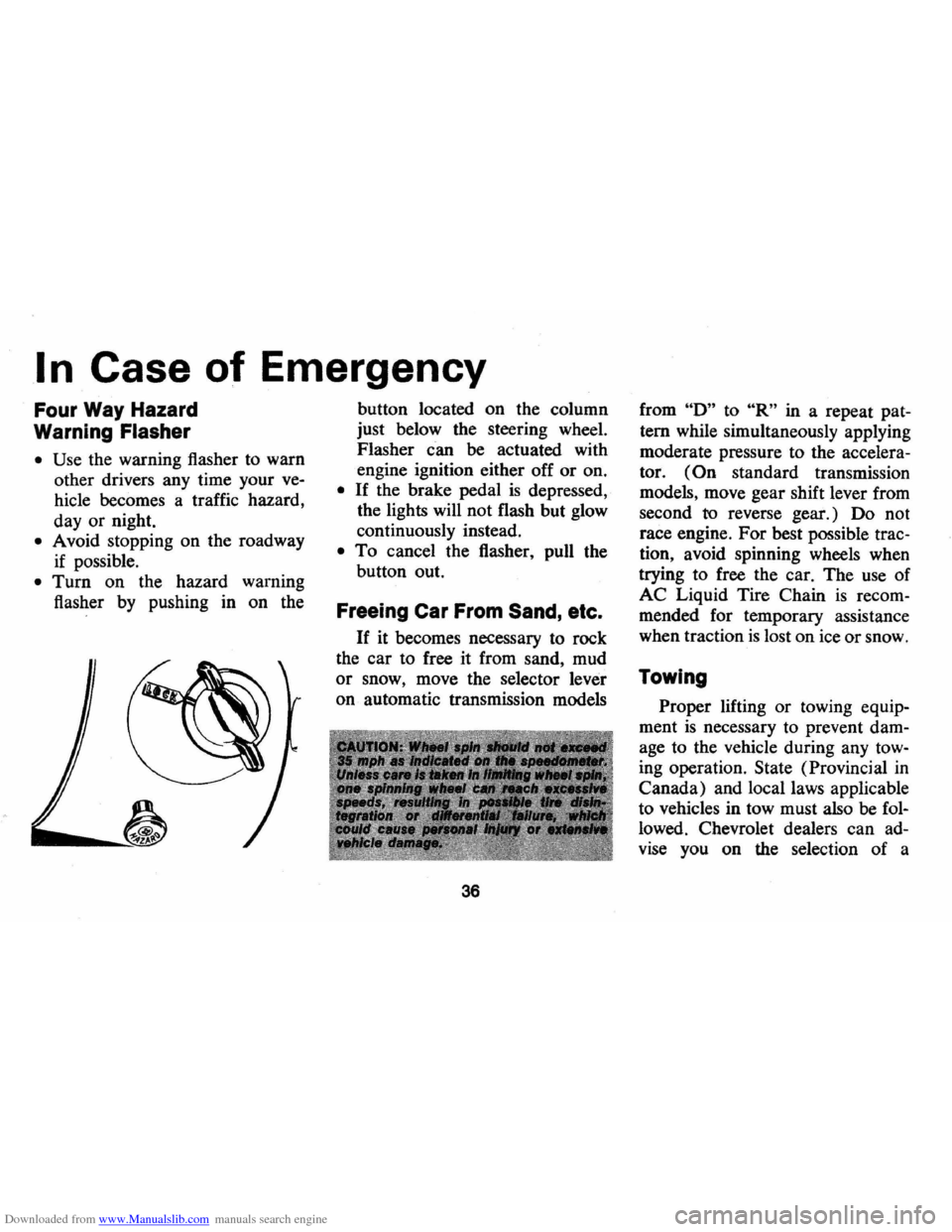
Downloaded from www.Manualslib.com manuals search engine .1 n Case of Emergency
Four Way Hazard
Warning Flasher
• Use the warning flasher to warn
other drivers any time your
ve·
hicle becomes a traffic hazard,
day or night.
• Avoid stopping on the roadway
if possible.
• Turn on the hazard warning
flasher
by pushing in on the
.---~
button located on the column
just below the steering wheel.
Flasher can be actuated with
engine ignition either off or on.
• If the brake pedal is depressed,
the lights will not flash but glow
continuously instead.
• To cancel the flasher, pull the
button out.
Freeing Car From Sand, etc.
If it becomes necessary to rock
the car to free it from sand, mud
or snow, move the selector lever
on automatic transmission models
36
from "0" to "R" in a repeat pat·
tern while simultaneously applying
moderate pressure to the
accelera
tor. (On standard transmission
models, move gear shift lever from
second
to reverse gear.) 00 not
race engine.
For best possible trac
tion, avoid spinning wheels when
trying to free the car. The use of
AC Liquid Tire Chain is recom
mended for temporary assistance
when traction
is lost on ice or snow.
Towing
Proper lifting or towing equip
ment is necessary to prevent dam
age to the vehicle during any tow
ing operation. State (Provincial in
Canada) and local laws applicable
to vehicles in tow must also be
fol
lowed . Chevrolet dealers can ad
vise you on the selection of a
Page 40 of 84
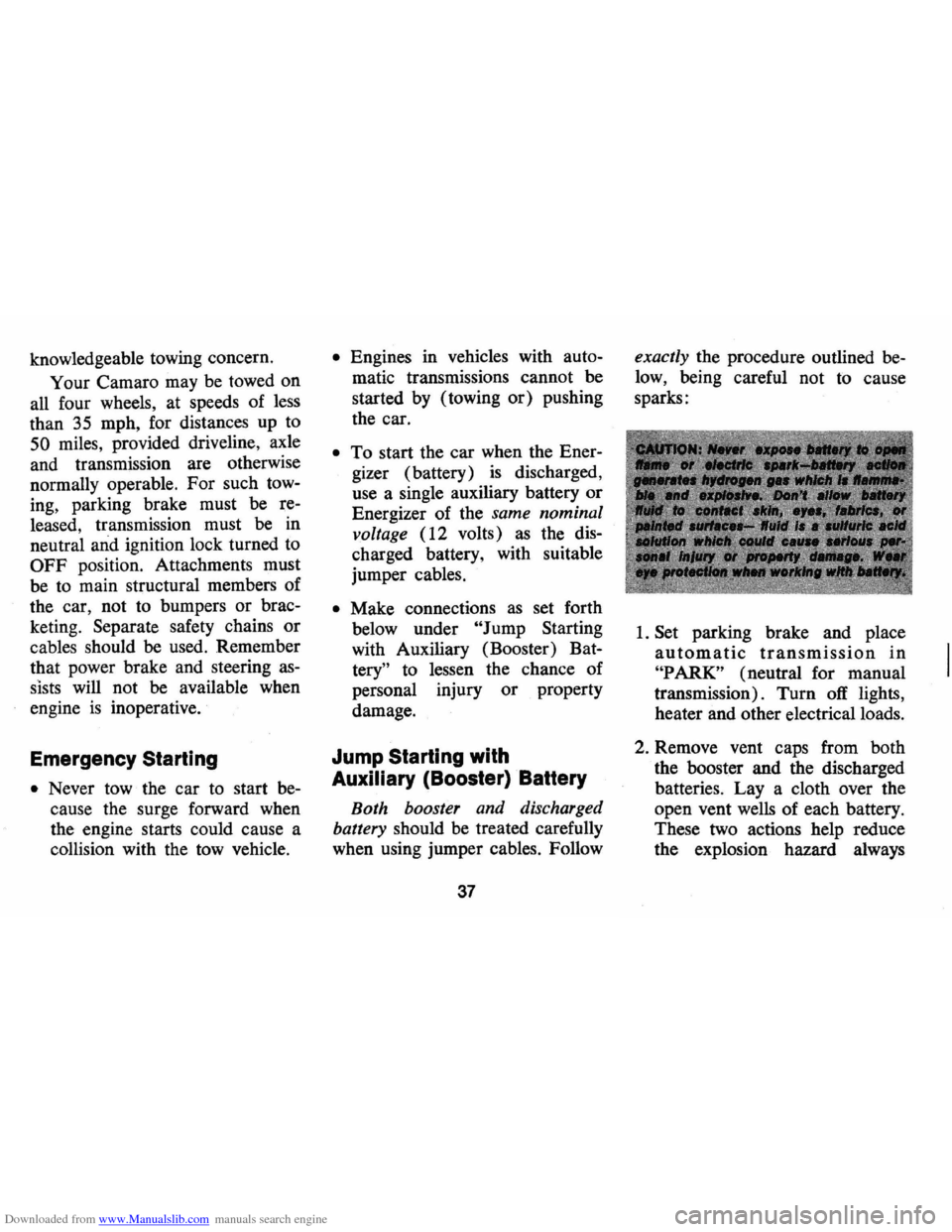
Downloaded from www.Manualslib.com manuals search engine knowledgeable towing concern.
Your Camaro may be towed on
all four wheels, at speeds of
less
than 35 mph, for distances up to
50 miles, provided driveline, axle
and transmission are otherwise
normally operable. For such tow
ing, parking brake must be re
leased, transmission must be in
neutral
and ignition lock turned to
OFF position. Attachments must
be to main structural members of
the car, not to bumpers or brac
keting. Separate safety chains
or
cables should be used. Remember
that power brake and steering
as
sists will not be available when
engine
is inoperative.
Emergency Starting
• Never tow the car to start be
cause the surge forward when
the engine starts could cause a
collision with the tow vehicle.
• Engines in vehicles with auto
matic transmissions cannot be
started by (towing
or) pushing
the car.
• To start the car when the Ener
gizer (battery)
is discharged,
use a single auxiliary battery or
Energizer of the same nominal
voltage
(12 volts) as the dis
charged battery, with suitable
jumper cables.
• Make connections as set forth
below under
"Jump Starting
with Auxiliary (Booster) Bat
tery" to lessen the chance of
personal injury
or property
damage.
Jump Starting with
Auxiliary (Booster) Battery
Both booster and discharged
battery should be treated carefully
when using jumper cables. Follow
37
exactly the procedure outlined be
low, being careful not to cause
sparks:
1. Set parking brake and place
automatic transmission in
"PARK" (neutral for manual
transmission). Turn
off lights,
heater and other electrical loads.
2. Remove vent caps from both
the booster and the discharged
batteries. Lay a cloth over the
open vent wells of each battery.
These two actions help reduce
the explosion hazard always
Page 60 of 84
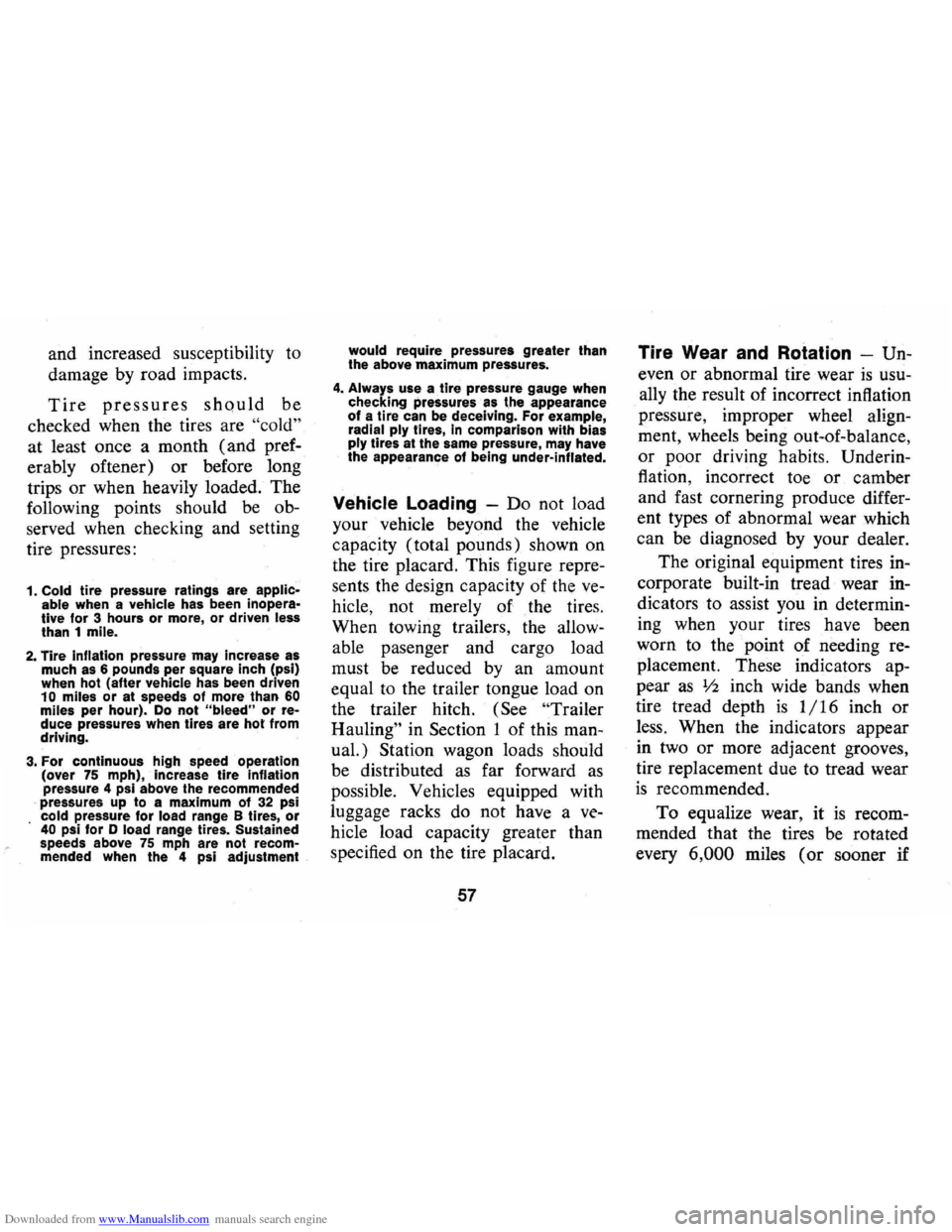
Downloaded from www.Manualslib.com manuals search engine and increased susceptibility to
damage by road impacts.
Tire pressures should be
checked when the tires are
"cold"
at least once a month (and pref
erably oftener) or before long
trips
or when heavily loaded. The
following points should be ob
served when checking and setting
tire pressures:
1. Cold tire pressure ratings are applic
able when a vehicle has been inopera
tive for 3 hours or more, or driven less than 1 mile.
2. Tire Inflation pressure may increase as
much as 6 pounds per square inch (psi)
when hot (after
vehicle has been driven 10 miles or at speeds of more than 60 miles per hour). Do not "bleed" or re
duce pressures when tires are hot from
driving.
3. For continuous high speed operation
(over 75 mph), Increase tire Inflation pressure 4 psi above the recommended
pressures up to a maximum of 32 psi cold pressure for load range B tires, or 40 psi for 0 load range tires. Sustained
speeds above 75 mph are not recommended when the 4 psi adjustment ,
would require pressures greater than
the above maximum pressures.
4. Always use a tire pressure gauge when
checking pressures as t,he appearance of a tire can be deceiving. For example,
radial ply fires, In comparison with bias ply tires at the same pressure, may have
the appearance of being under-inflated.
Vehicle Loading -Do not load
your vehicle beyond the vehicle
capacity (total pounds) shown on
the tire placard. This figure repre
sents the design capacity of the
ve
hicle, not merely of the tires.
When towing trailers, the allow
able pasenger and cargo load
must be reduced by an amount
equal to the trailer tongue load on
the trailer hitch.
(See "Trailer
Hauling"
in Section 1 of this man
ual.) Station wagon loads should
be distributed
as far forward as
possible. Vehicles equipped with
luggage racks do not have a
ve
hicle load capacity greater than
specified on the tire placard.
57
Tire Wear and Rotation -Un
even or abnormal tire wear is usu
ally the result of incorrect inflation
pressure, improper wheel align
ment, wheels being out-of-balance,
or poor driving habits. Underin
flation, incorrect toe or camber
and fast cornering produce differ
ent types of abnormal wear which
can be diagnosed by your dealer.
The original equipment tires in
corporate built-in tread wear
in
dicators to assist you in determin
ing when your tires ,have been
worn to the point of needing re
placement. These indicators ap
pear
as Ij2 inch wide bands when
tire tread depth
is 1/16 inch or
less. When the indicators appear
in two or more adjacent grooves,
tire replacement due to tread wear
is recommended.
To equalize wear, it
is recom
mended that the tires be rotated
every
6,000 miles (or sooner if
Page 81 of 84
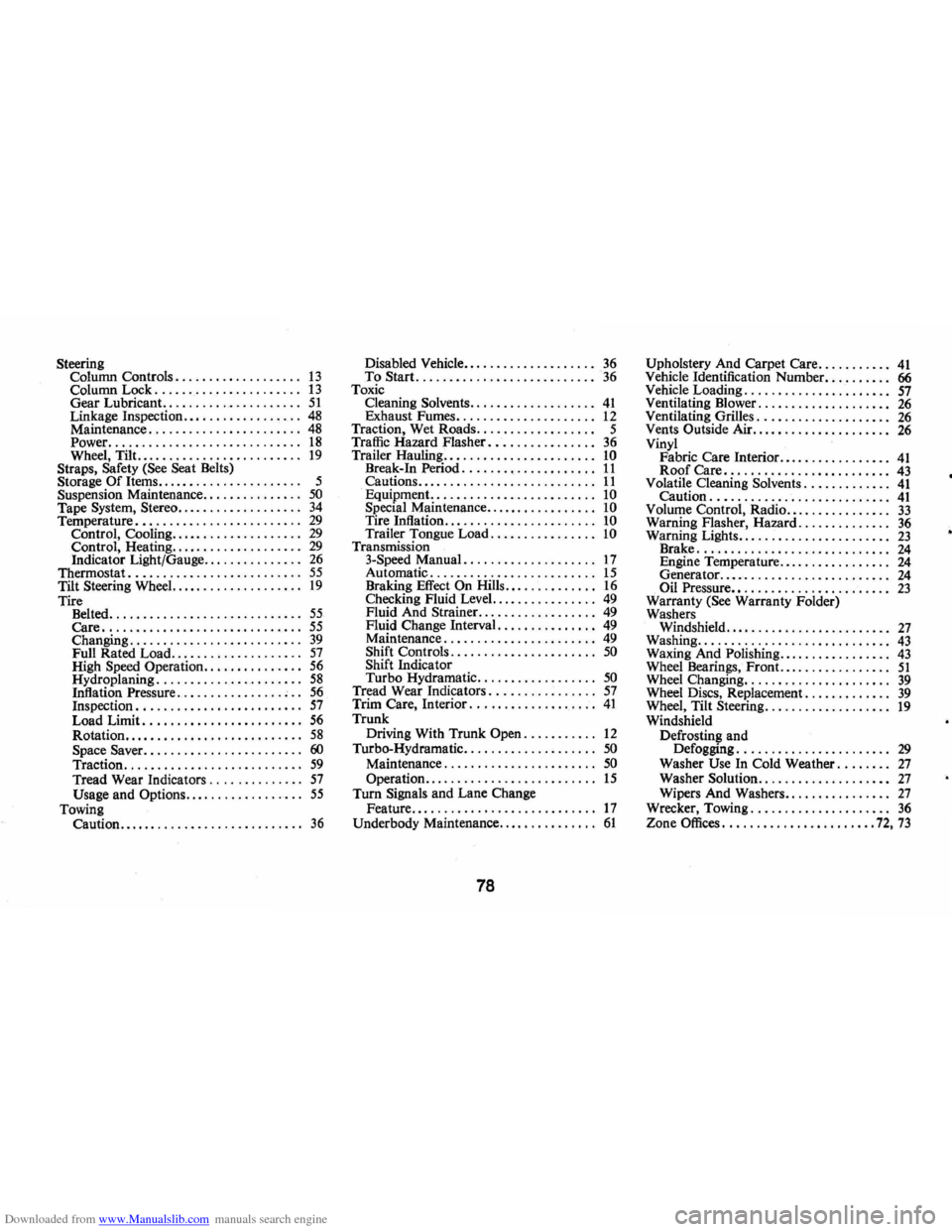
Downloaded from www.Manualslib.com manuals search engine Steering Column Controls. . . . . . . . . . . . . . . . . .. 13 Column Lock. . . . . . . . . . . . . . . . . . . . .. 13 Gear Lubricant. .................... 51 Linkage Inspection. . . . . . . . . . . . . . . . .. 48 Maintenance. . . . . . . . . . . . . . . . . . . . . .. 48 Power ....................... ...... 18 Wheel, Tilt ......................... 19 Straps, Safety (See Seat Belts) Storage Of Items..... . .. . . . . . . . . . . . . .. 5 Suspension Maintenance. . . . . . . . . . . . . .. 50 Tape System, Stereo. . . . . . . . . . . . . . . . . .. 34 Temperature ........... ............ " 29 Control , Cooling.. . .. . . . . . . . . . . . . . .. 29 Control, Heating. . . . . . . . . . . . . . . . . . .. 29 Indicator Light/Gauge. . . . . . . . . . . . . .. 26 Thermostat ....... ................... 55 Tilt Steering Wheel.. . . . . . . . . . . . . . . . . .. 19 Tire
Belted .. ........................... 55 Care ........................ ...... 55 Changing ........................ " 39 Full Rated Load ............ ....... . 57 High Speed Operation ............... 56 Hydroplaning. . . . . . . . . . . . . .. . . . . . .. 58 Inflation Pressure ............. ... , .. 56 Inspection ............ ... ........ " 57 Load Limit. . . . . . . . . . . . . . . . . . . . . . .. 56 Rotation ..... ............ .......... 58 Space Saver ........................ 60 Traction ............. .............. 59 Tread Wear Indicators .... ... ....... 57 Usage and Options... . . . . . . . . . . . . . .. 55 Towing
Caution ........... ................ . 36
Disabled Vehicle .................... 36 To Start. .... ........ .............. 36 Toxic
Cleaning Solvents ................... 41 Exhaust Fumes ..................... 12 Traction, Wet Roads. . . . . . . . . . . . . . . . . . 5
Traffic Hazard Flasher. . . . . . . . . . . . . . .. 36 Trailer Hauling.. . . . . . . . . . . . .. . . . . .. .. 10 Break-In Period .................... 11 Cautions . . . . . . . . . . . . . . . . . . . . . . . . . .. 11 Equipment.. . . . . . . . . . . . . . . . . . . . . . .. 10 Special Maintenance ............. .... 10 Tire Inflation ......... .............. 10 Trailer Tongue Load. . . . . . . . . . . . . . .. 10 Transmission 3-Speed Manual. . . . . . . . . . . . . . . . . . .. 17 Automatic .................. ....... 15 Braking Effect On Hills .............. 16 Checking Fluid Level. . . . . . . . . . . . . . .. 49 Fluid And Strainer.. . . . . . . . . . . . . . . .. 49 Fluid Change Interval. . . . . . . . . . . . . . . 49 Maintenance. . . . . . . . . . . . . . . . . . . . . .. 49 Shift Controls.. . . . . . . .. .. . . . . . . . ... 50 Shift Indicator
Turbo Hydramatic .................. 50 Tread Wear Indicators ................ 57 Trim Care, Interior .................. , 41 Trunk
Driving With Trunk Open ........... 12 Turbo-Hydramatic . . . . . . . . . . . . . . . . . . .. 50 Maintenance. . . . . . . . . . . . . . . . . . . . . .. 50 Operation. . . . . . . . . . . . . . . . . . . . . . . . . . 15 Turn Signals and Lane Change
Feature ................. ........... 17 Underbody Maintenance. . . . . . . . . . . . . . . 61
78
Upholstery And Carpet Care ........... 41 Vehicle Identification Number .......... 66 Vehicle Loading ................... '" 57 Ventilating Blower .................... 26 Ventilating Grilles .................... 26 Vents Outside Air ..................... 26 Vinyl Fabric Care Interior ........... .. .... 41 Roof Care. . . . . . . . . . . . . . . . . . . . . . . .. 43 Volatile Cleaning Solvents. . . . . . . . . . . .. 41 Caution ........................... 41 Volume Control, Radio ................ 33 Warning Flasher, Hazard .............. 36 Warning Lights. . . . . . . . . . . . . . . . . . . . . .. 23 Brake ............................. 24 Engine Temperature ....... .......... 24 Generator .......................... 24 Oil Pressure.. . . . . . . . . . . . . . . . . . . . . .. 23 Warranty (See Warranty Folder)
Washers
Windshield
...................... '" 27 Washing ............................. 43 Waxing And Polishing.. .. . . . .. . . . . .. .. 43 Wheel Bearings , Front .... . . . . . . . . . . . .. 51 Wheel Changing. . . . . . . . . . . . . . . . . . . . .. 39 Wheel Discs, Replacement. . . . . . . . . . . .. 39 Wheel, Tilt Steering ................... 19 Windshield
Defrosting and
Defogging . . . . . . . . . . . . . . . . . . . . .
.. 29 Washer Use In Cold Weather ........ 27 Washer Solution ............ .......• 27 Wipers And Washers.. . . . . . . . . . . . . .. 27 Wrecker, Towing. . . . . . . . . . . . . . . . . . . .. 36 Zone Offices ......... ............ .. 72, 73